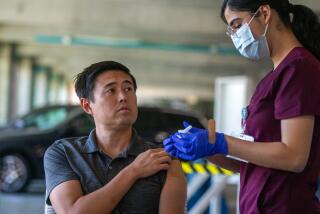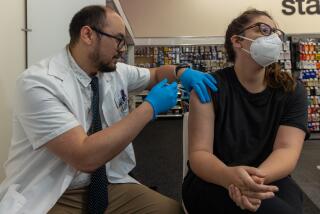Flu death toll rises in California
The number of Californians under 65 who’ve died of the flu has jumped to 42, compared with nine at the same time last year, state officials said Friday.
The flu season, which runs from October through May, typically peaks in February. Public health officials say they don’t yet know whether the flu season is peaking earlier than normal, or if this year will be a particularly tough one for the flu.
“We are still early in the season but … the number of deaths so far is significantly higher than at the same time in the previous several influenza seasons,” said Dr. James Watt, chief of the division of communicable disease control with the California Department of Public Health, in a press call with reporters this week.
Thousands of people in California started showing up at doctors’ offices and hospitals in December with the flu. Since then, emergency rooms have been crowded with long wait times, and patients have struggled to get doctor appointments as well as flu medications.
Most people in California and nationwide are catching a strain of influenza A known as H3N2, which tends to be deadlier than other strains. H3N2 was to blame for Australia’s most recent, brutal flu season, which led to record numbers of sick people as well as the nickname “Aussie flu.”
In California, state officials collect flu death data only among people under 65. So many older people die of the flu each year that monitoring deaths under 65 reveals more about the severity of the flu season, they say.
Among people of all ages, 36 people have died in Los Angeles County this flu season and 91 in San Diego County, officials say.
“Influenza is widespread,” said L.A. County public health department director Dr. Barbara Ferrer in a news conference this week. “There’s almost no area in the county that’s seen no influenza activity at this point.”
Officials say visits to L.A. County emergency rooms for influenza symptoms are more than twice as high as they were at the same time last year.
This month, Kaiser Permanente members received texts and calls warning them of long wait times in the urgent care and ERs. Kaiser’s phone line that fields patient calls has also seen a big increase in activity recently, said Dr. Gunter Rieg, regional infection control officer for Kaiser Permanente in Southern California.
“It’s a huge surge of influenza this year,” he said.
Officials say that it’s not too late to get the flu shot. The vaccine is recommended for everyone 6 months of age or older, and is especially important for pregnant women, children under 5, adults over 65 and others who are at high-risk for complications from the flu.
Experts say the flu shot may be only 30% effective this year, but can still reduce the severity of symptoms for people who get the flu. It takes about two weeks for the flu shot to take effect.
“At this time, it’s the best tool we have,” Ferrer said.
Flu activity varies across the state. Silicon Valley’s Camino Hospital has been treating double the number of flu patients it typically sees this time of year.
“It is higher this week than last week, which was higher than the week before, so we haven’t seen a peak yet,” said Dr. Daniel Shin, an infectious disease physician at the hospital.
Louise White, chief nursing officer for Sharp Grossmont Hospital in San Diego County, said that the number of patients coming in for the flu appears to have leveled off. San Diego was the first part of the state severely hit by the flu and many hospitals there reported seeing fewer patients this week.
“The volumes of patients coming in increased dramatically during Christmas week,” White said. “It probably peaked about last weekend.”
soumya.karlamangla@latimes.com
Twitter: @skarlamangla
ALSO
Severe flu brings medicine shortages, packed ERs and a rising death toll in California
Wildfires stressed wine country’s healthcare system, creating a crisis and a warning for future
As health workers deal with mass shootings and fires, more hospitals are looking to help them cope
More to Read
Start your day right
Sign up for Essential California for news, features and recommendations from the L.A. Times and beyond in your inbox six days a week.
You may occasionally receive promotional content from the Los Angeles Times.







